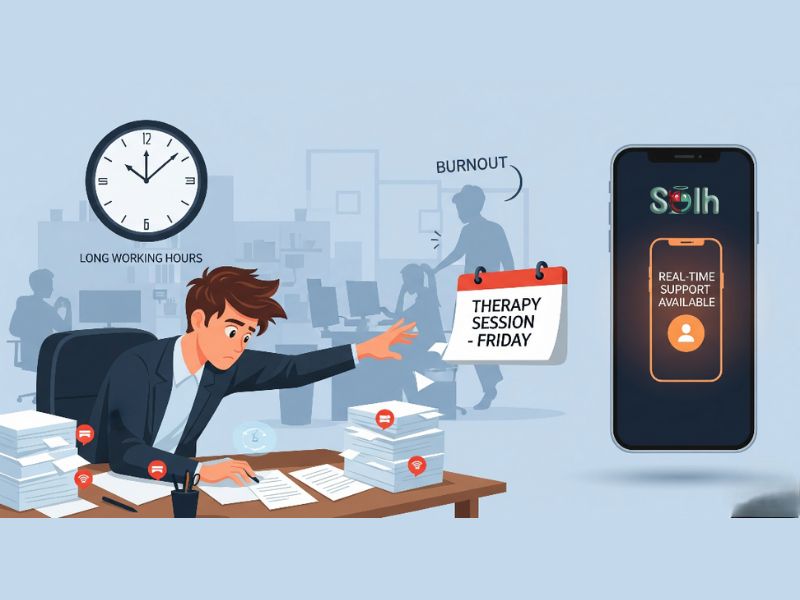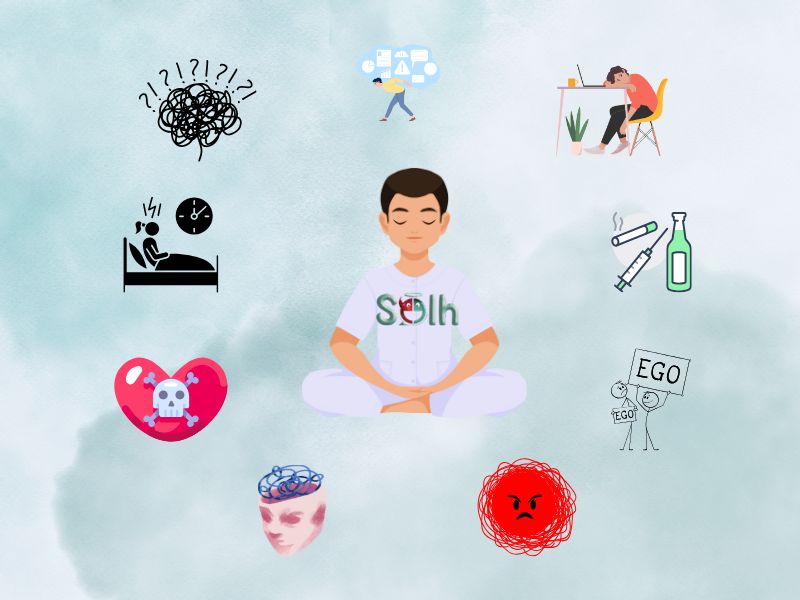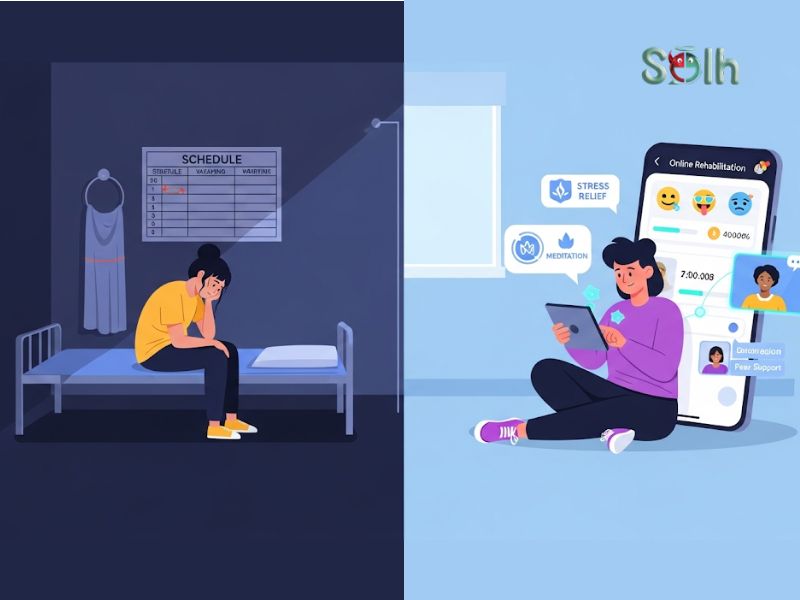The modern workplace has become a breeding ground for stress-related mental health challenges, with burnout rates reaching epidemic proportions across industries. In response, many organizations have adopted therapy-only models for workplace stress management, offering employee assistance programs (EAPs) and counseling services as their primary intervention strategy. While these services provide valuable support, mounting evidence suggests that therapy-only approaches are insufficient to address the complex, multifaceted nature of workplace stress. Understanding why these models fall short is crucial for developing more effective, comprehensive solutions.
The Reactive Nature of Therapy-Only Models For Workplace Stress
Traditional therapy-only approaches operate on a reactive framework, addressing stress-related issues after they've already manifested into significant problems. By the time employees seek therapeutic intervention, they may already be experiencing burnout, anxiety disorders, or depression. This reactive model fails to prevent the cascade of negative effects that chronic workplace stress can trigger, including decreased productivity, increased absenteeism, and higher healthcare costs.
The therapy-only models for workplace stress itself require time to show results, often taking weeks or months to achieve meaningful outcomes. During this period, employees continued to operate within the same stressful work environment that contributed to their initial distress. Without addressing the root causes of workplace stress, therapy becomes a temporary bandage rather than a sustainable solution, leading to recurring cycles of stress and intervention.
This is where proactive stress management becomes essential. Modern solutions like the Solh, Stress Management App offer regular stress check-ups that help identify stress patterns before they escalate into serious problems. Through consistent monitoring and early intervention, employees can address stress at its onset rather than waiting for it to become overwhelming.
Addressing Symptoms Rather Than Systemic Issues
Therapy-only models for workplace stress focus primarily on helping individuals develop coping mechanisms and resilience strategies, essentially teaching employees to better tolerate problematic work conditions. While personal resilience is valuable, this approach places the burden of stress management entirely on the employee rather than examining and addressing the organizational factors that create stress in the first place.
Workplace stress often stems from systemic issues such as unrealistic workloads, poor management practices, lack of autonomy, insufficient resources, or toxic organizational cultures. No amount of individual therapy can fully compensate for dysfunctional work environments. When organizations rely solely on therapy-only models, they inadvertently perpetuate harmful workplace conditions by treating the symptoms rather than the disease.
This approach can also lead to victim-blaming, where employees who continue to struggle with stress are seen as lacking resilience or not taking advantage of available resources rather than recognizing that the workplace itself may be fundamentally problematic.
The Accessibility and Stigma Barriers
Despite good intentions, therapy-only models face significant accessibility challenges that limit their effectiveness. Many employees avoid seeking therapeutic support due to the persistent stigma surrounding mental health treatment, particularly in competitive work environments where seeking help might be perceived as a weakness or incompetence.
Practical barriers further compound these issues. Traditional therapy requires scheduling during business hours, which can conflict with work responsibilities or require employees to disclose their participation to supervisors. The time commitment required for regular therapy sessions can become an additional source of stress for already overwhelmed employees.
Geographic limitations also play a role, particularly for organizations with remote or distributed workforces. Access to quality stress management and mental health professionals varies significantly by location, and waitlists for therapy services can extend for weeks or months, delaying crucial interventions when employees need support most urgently.
These accessibility challenges highlight the need for more flexible, technology-driven solutions that can provide support anytime, anywhere. Digital platforms eliminate geographical barriers and offer anonymity that helps reduce stigma, making mental health support more approachable for employees who might otherwise hesitate to seek help.
The Lack of Real-Time Support
Workplace stress doesn't operate on a therapist's schedule. Stressful situations arise unexpectedly throughout the workday, from difficult client interactions to sudden deadline changes or interpersonal conflicts. Therapy-only models for workplace stress provide support during scheduled sessions but leave employees without resources during the moments when stress is actively occurring.
This gap between when stress happens and when support is available can be particularly problematic for acute stress situations. Employees may experience panic attacks, overwhelming anxiety, or severe emotional distress during work hours, with no immediate access to professional support. By the time their next therapy session arrives, the acute phase may have passed, but the underlying stress patterns remain unaddressed.
Applications like Solh address this critical gap by providing immediate stress management guidance whenever it's needed. Through stress-checking tests and on-demand resources, employees can access real-time support during stressful moments, helping them manage acute stress before it compounds into larger mental health challenges.
The Need for Comprehensive, Multi-Modal Approaches
Effective stress management in the workplace requires a comprehensive approach that addresses both individual and organizational factors. This includes primary prevention strategies that modify work environments to reduce stress-producing conditions, such as implementing flexible work arrangements, improving management training, and creating clear communication channels.
Secondary prevention involves early identification and intervention before stress escalates into serious mental health issues. This might include stress monitoring systems, peer support programs, and on-demand resources that provide immediate assistance when needed.
Technology-enabled solutions can bridge many gaps left by therapy-only models for workplace stress. AI-powered stress detection systems can identify concerning patterns before they become severe, while mobile applications can provide real-time coping strategies and support during stressful moments. These tools complement traditional therapy by offering immediate, accessible intervention when needed most.
The Solh Wellness, Stress Management App exemplifies this comprehensive approach by combining multiple intervention strategies in one accessible platform. Its features include regular mental health check-ups that track stress patterns over time, personalized stress management guidance based on individual needs, and stress-checking tests that provide immediate assessment and recommendations. This multi-layered approach ensures that employees have continuous support rather than intermittent intervention.
Moving Beyond Therapy-Only Models
Organizations seeking to effectively address workplace stress must move beyond therapy-only models toward integrated approaches that combine individual support with systemic change. This includes regular assessment of workplace stressors, management training focused on employee wellbeing, and the implementation of technology-driven solutions that provide continuous support.
The most effective strategies for stress management in the workplace are to recognize that employee well-being is fundamentally interconnected with organizational health. By addressing both individual resilience and workplace conditions, organizations can create sustainable solutions that prevent stress rather than simply treating its consequences.
Forward-thinking organizations are already incorporating comprehensive digital stress management solutions into their employee wellness programs. These platforms provide the flexibility and accessibility that traditional therapy-only models lack while offering the continuous support that modern workplace stress demands.
Conclusion
While therapy remains an important component of workplace stress management support, therapy-only models for workplace stress are insufficient to address the complex, systemic nature of workplace stress. The reactive approach, which focuses on individual adaptation rather than organizational change, accessibility barriers, and a lack of real-time support all contribute to the limitations of these models. Moving forward, organizations must adopt comprehensive approaches that integrate therapeutic support with proactive stress prevention, systemic workplace improvements, and technology-enabled solutions to provide continuous, accessible support for employee well-being.
Take Action for Your Mental Health Today
Don't wait for stress to overwhelm you. The Solh Wellness, Stress Management App provides comprehensive and accessible support to help you manage workplace stress effectively. With features designed for the modern professional, including:
- Regular Stress Check-ups - Track your stress patterns and mental health status over time
- Personalized Stress Management Guidance - Receive tailored strategies based on your specific needs and stress triggers
- Instant Stress Checking Tests - Get immediate assessments and recommendations when you need them most
- 24/7 Accessibility - Access support anytime, anywhere, without scheduling conflicts or stigma
Take control of your excessive stress with a solution that works with your schedule, not against it. Download the Solh app today and experience the difference that comprehensive, technology-enabled stress management support can make in your professional and personal life.
Your mental health matters. Make it a priority.
Let’s Connect!


